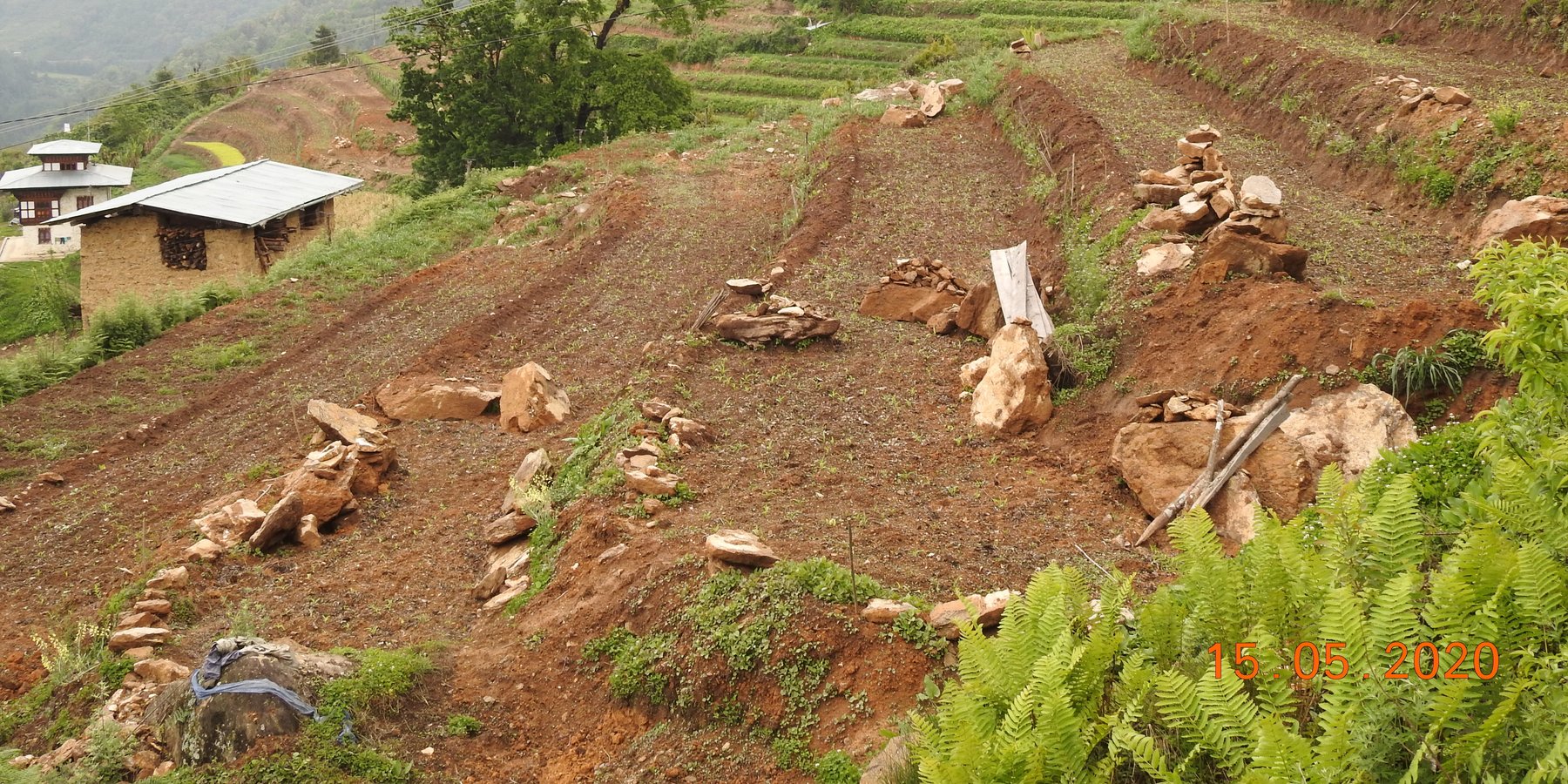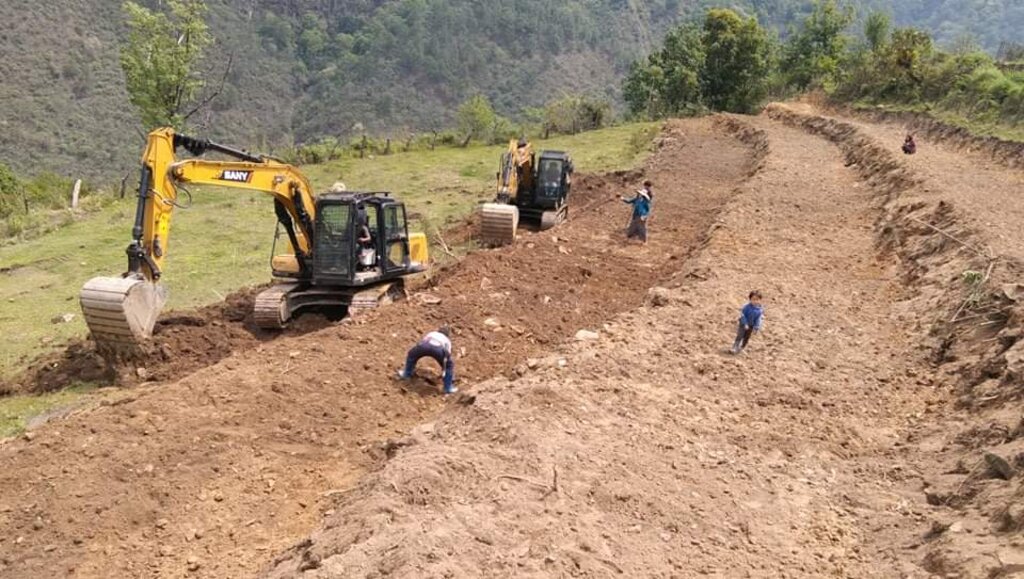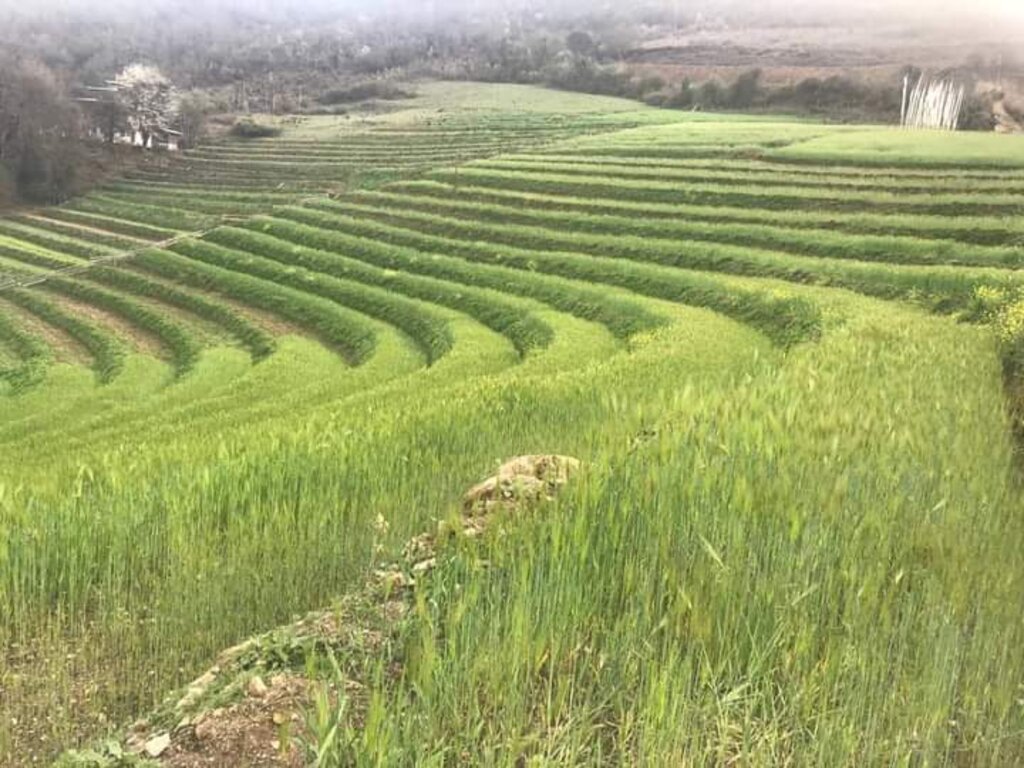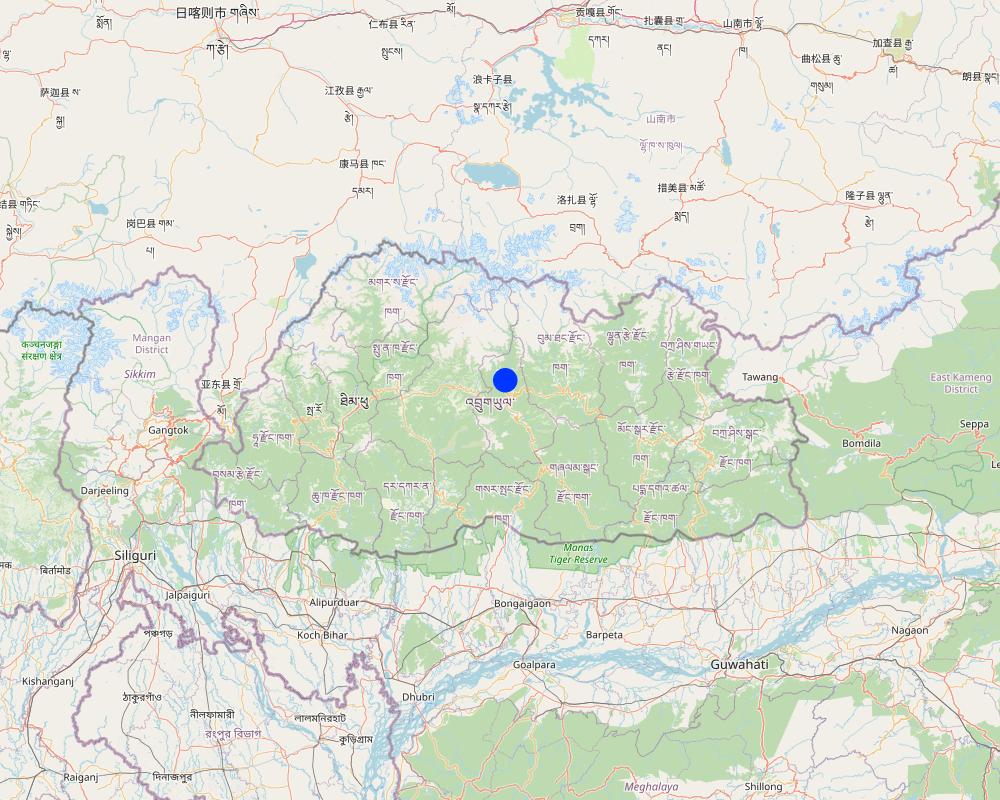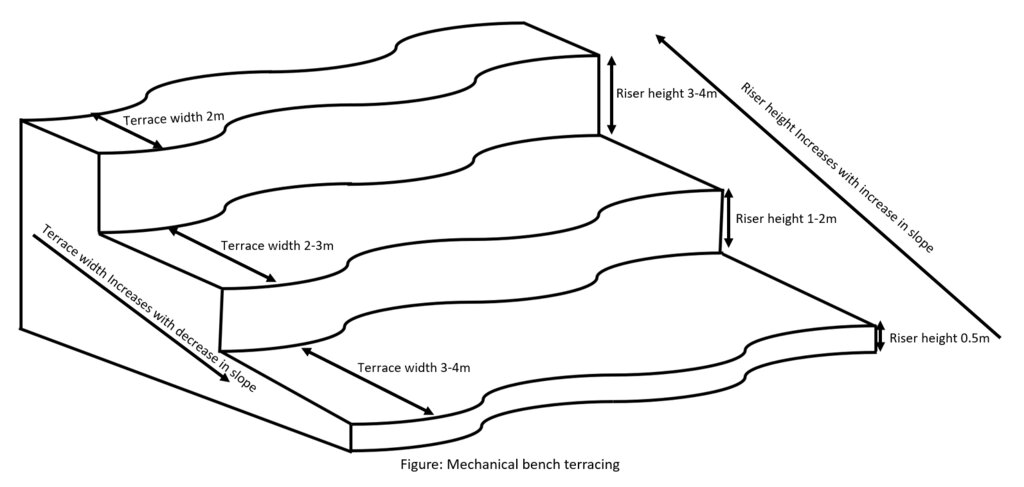Mechanical Bench Terracing [不丹]
- 创建:
- 更新:
- 编制者: ONGPO LEPCHA
- 编辑者: Tashi Wangdi
- 审查者: William Critchley, Rima Mekdaschi Studer
Thruel Chhey Laglen Thaptey Aring Chayni (འཕྲུལ་ཆས་ལག་ལེན་འཐབ་སྟེ་ཨ་རིང་བཅད་ནི)
technologies_6836 - 不丹
查看章节
全部展开 全部收起1. 一般信息
1.2 参与该技术评估和文件编制的资源人员和机构的联系方式
关键资源人
土地使用者:
Penjor Tenzin
Bemji village
不丹
有助于对技术进行记录/评估的项目名称(如相关)
Strengthening national-level institutional and professional capacities of country Parties towards enhanced UNCCD monitoring and reporting – GEF 7 EA Umbrella II (GEF 7 UNCCD Enabling Activities_Umbrella II)有助于对技术进行记录/评估的机构名称(如相关)
National Soil Services Centre, Department of Agriculture, Ministry of Agriculture & Livestock (NSSC) - 不丹1.3 关于使用通过WOCAT记录的数据的条件
编制者和关键资源人员接受有关使用通过WOCAT记录数据的条件。:
是
1.4 所述技术的可持续性声明
这里所描述的技术在土地退化方面是否存在问题,导致无法被认为是一种可持续的土地管理技术?:
否
注释:
The technology is not problematic with regard to land degradation. Indeed, the terraces helps in avoiding and reversing land degradation by reducing surface erosion, retaining soil moisture and improve soil fertility.
2. SLM技术的说明
2.1 技术简介
技术定义:
Soil erosion by water is one of the major problems in hilly or mountainous countries like Bhutan. In such areas, effective erosion control measures are required to reduce the slope gradient and minimize surface runoff. Among many SLM interventions, mechanical bench terracing is one of the most widely promoted and popular technologies in Bhutan.
2.2 技术的详细说明
说明:
Bhutan is one of the most mountainous countries in the world and agricultural activities are carried out on slopes up to 35 degrees (70 percent). Erosion by water is one of the major causes of land degradation. In such areas, effective erosion control measures include reducing slope gradients to minimize runoff by creating a series of level platforms or “bench terraces” along the contour. Current bench terracing is made using small to medium-sized earthmoving machines called excavators, and thus the technology is called Mechanical Bench Terracing. This is one of the main SLM measures promoted widely and most preferred by landowners who claim that it reduces soil erosion, improves soil fertility, conserves soil moisture, and eases field operations. Bench terraces create impact by 1) helping minimize the risk of soil erosion caused by surface runoff, 2) effectively regulating water flow, and 3) preventing soil saturation by allowing better drainage. Additionally, bench terracing transforms previously unusable or less productive land into cultivable areas, maximizing the utilization of limited land resources. A typical bench terrace on a 20-25 degree slope has a terrace bed of 2-5 m meters and a riser of 0.75 to 1 metre high. The risers are made of earth and the terrace is made flat most of the time to prevent runoff of rainwater.
Establishing and maintaining bench terracing involves a feasibility study of the sites, participatory planning, hands-on training of the landowners, and surveying of contour lines using A-frames. There is also procurement of construction materials, arranging labour and machines and training machine operators. Once constructed, proper water management, soil fertility, and nutrient management practices are crucial for ensuring the long-term sustainability and productivity of the terraced land. Furthermore, knowledge and training on crop cultivation techniques, field management, and maintenance are vital to optimize the benefits.
In summary, bench terracing offers numerous benefits. These include:
1) Overall reduction in land degradation
2) Soil conservation by prevention of erosion by runoff
3) Conservation of soil fertility
3) Increase arable land available for cultivation
4) Ease of mechanized field operations with level terrace beds
5) Water conservation and drainage6) Improved crop production
Land users like the fact that bench terracing provides land that is easier to work. The land is better utilized for cultivation, resulting in improved productivity. Land users generally appreciate its numerous benefits in terms of land productivity, soil conservation, and water management. What they dislike are the expense and labour input if expenditure has to be borne by the land owners and neither machine operators nor small to medium-sized machines are readily available in the market for hire.
2.3 技术照片
2.5 已应用该技术的、本评估所涵盖的国家/地区/地点
国家:
不丹
区域/州/省:
Trongsa Dzongkhag (district)
有关地点的进一步说明:
Bemji Village, Nubi Gewog (block), Trongsa Dzongkhag (district)
具体说明该技术的分布:
- 均匀地分布在一个区域
如果技术均匀分布在一个区域,则指定覆盖的区域(单位为平方千米):
1.0097
如果不知道精确的区域,请注明大致覆盖的区域:
- < 0.1 平方千米(10 公顷)
技术现场是否位于永久保护区?:
否
Map
×2.6 实施日期
注明实施年份:
2019
2.7 技术介绍
详细说明该技术是如何引入的:
- 通过项目/外部干预
注释(项目类型等):
Mechanical bench terracing in Bemji Village was implemented by Dzongkhag Agriculture Sector with technical support from the National Soil Services Center and funded by GEF-LDCF, UNDP
3. SLM技术的分类
3.1 该技术的主要目的
- 改良生产
- 减少、预防、恢复土地退化
- 结合其他技术保护流域/下游区域
- 创造有益的经济影响
- Improve farm mechanization
3.2 应用该技术的当前土地利用类型
同一土地单元内混合使用的土地::
否

农田
- 一年一作
年作 - 具体指明作物:
- 谷类 - 水稻(湿地)
- 谷类 - 小麦(春季)
- 根/块茎作物 - 土豆
- 蔬菜 - 叶菜(色拉、卷心菜、菠菜和其他)
每年的生长季节数:
- 2
具体说明:
Paddy followed by Wheat or barley
采用间作制度了吗?:
否
采用轮作制度了吗?:
是
如果是,请具体说明:
Paddy followed by wheat or barley/vegetables
注释:
The crops are grown mostly for self consumption, however, the surplus productions are sold at the weekly local market in Trongsa Dzongkhag (District).
3.3 由于技术的实施,土地使用是否发生了变化?
由于技术的实施,土地使用是否发生了变化?:
- 是(请在技术实施前填写以下有关土地利用的问题)
同一土地单元内混合使用的土地::
否

农田
- 一年一作
年作 - 具体指明作物:
- 谷类 - 大麦
- 谷类 - 小麦(春季)
采用间作制度了吗?:
否
采用轮作制度了吗?:
是
如果是,请具体说明:
Paddy followed by Wheat/Barley/vegetables
注释:
In the past when terracing was not done only flat land was used to grow cereals but sloppy ones were left as grazing land or kept uncultivated. After terracing land user were able to use most of their land for cropping.
3.4 供水
该技术所应用土地的供水:
- 混合雨水灌溉
注释:
According to the land user, the water supply is mostly rainfed; however, water for irrigation is also readily available.
3.5 该技术所属的SLM组
- 横坡措施
3.6 包含该技术的可持续土地管理措施

结构措施
- S1:阶地
3.7 该技术强调的主要土地退化类型

土壤水蚀
- Wt:表土流失/地表侵蚀
- Wg:冲沟侵蚀/沟蚀

土壤风蚀
- Et:表土流失
3.8 防止、减少或恢复土地退化
具体数量名该技术与土地退化有关的目标:
- 防止土地退化
- 减少土地退化
注释:
Bench terracing is generally constructed to prevent and reduce land degradation due to surface runoff caused by water/rainfall.
4. 技术规范、实施活动、投入和成本
4.1 该技术的技术图纸
技术规范(与技术图纸相关):
Technical Drawing of bench which are made mechanically
作者:
Ongpo Lepcha
日期:
21/11/2023
4.2 有关投入和成本计算的一般信息
具体说明成本和投入是如何计算的:
- 每个技术区域
注明尺寸和面积单位:
2.4 acres
其它/国家货币(具体说明):
Ngultrum
如相关,注明美元与当地货币的汇率(例如1美元=79.9巴西雷亚尔):1美元=:
80.62
4.3 技术建立活动
| 活动 | 时间(季度) | |
|---|---|---|
| 1. | Feasibility study | Based on land user and extension agents convenience |
| 2. | Participatory SLM Action planning | Based on land user and extension agent convenience |
| 3. | Hands on training for land owners and machine operator | Prior to actual implementation of the activity |
| 4. | Bench terracing by machine | When the land is fallow (Nov-Feb) |
| 5. | Leveling and removal of stones | Based on land user convenience |
注释:
It take about three weeks to implement all the activities in 2.40 acres of land
4.4 技术建立所需要的费用和投入
| 对投入进行具体说明 | 单位 | 数量 | 单位成本 | 每项投入的总成本 | 土地使用者承担的成本% | |
|---|---|---|---|---|---|---|
| 劳动力 | Labour | person-days | 98.0 | 500.0 | 49000.0 | 100.0 |
| 设备 | Excavator | nos | 1.0 | 40916.0 | 40916.0 | |
| 技术建立所需总成本 | 89916.0 | |||||
| 技术建立总成本,美元 | 1115.31 | |||||
如果土地使用者负担的费用少于100%,请注明由谁负担其余费用:
The land owner bore about 32% of the total cost while the remaining cost was covered by the GEF-LDCF Project
4.5 维护/经常性活动
| 活动 | 时间/频率 | |
|---|---|---|
| 1. | Maintenance of terrace bunds | When ever necessary |
注释:
According to the land users, maintenance of the technology involved very little expense because once the terrace was formed the land became more stable.
4.6 维护/经常性活动所需要的费用和投入(每年)
注释:
Once the terraces are well established the maintenance costs are minimal.
5. 自然和人文环境
5.1 气候
年降雨量
- < 250毫米
- 251-500毫米
- 501-750毫米
- 751-1,000毫米
- 1,001-1,500毫米
- 1,501-2,000毫米
- 2,001-3,000毫米
- 3,001-4,000毫米
- > 4,000毫米
有关降雨的规范/注释:
The data used was from the nearest weather station of the National Center for Hydrology and Meteorology (NCHM).
注明所考虑的参考气象站名称:
https://www.nchm.gov.bt/home/pageMenu/906
农业气候带
- 半干旱
Warm temperate zone
5.2 地形
平均坡度:
- 水平(0-2%)
- 缓降(3-5%)
- 平缓(6-10%)
- 滚坡(11-15%)
- 崎岖(16-30%)
- 陡峭(31-60%)
- 非常陡峭(>60%)
地形:
- 高原/平原
- 山脊
- 山坡
- 山地斜坡
- 麓坡
- 谷底
垂直分布带:
- 0-100 m a.s.l.
- 101-500 m a.s.l.
- 501-1,000 m a.s.l.
- 1,001-1,500 m a.s.l.
- 1,501-2,000 m a.s.l.
- 2,001-2,500 m a.s.l.
- 2,501-3,000 m a.s.l.
- 3,001-4,000 m a.s.l.
- > 4,000 m a.s.l.
说明该技术是否专门应用于:
- 不相关
5.3 土壤
平均土层深度:
- 非常浅(0-20厘米)
- 浅(21-50厘米)
- 中等深度(51-80厘米)
- 深(81-120厘米)
- 非常深(> 120厘米)
土壤质地(表土):
- 中粒(壤土、粉土)
表土有机质:
- 高(>3%)
5.4 水资源可用性和质量
地表水的可用性:
中等
水质(未处理):
仅供农业使用(灌溉)
水质请参考::
地表水
水的盐度有问题吗?:
否
该区域正在发生洪水吗?:
否
关于水质和水量的注释和进一步规范:
However, excess rain can cause flooding in the terrace but instances like this has never happened.
5.5 生物多样性
物种多样性:
- 低
栖息地多样性:
- 低
关于生物多样性的注释和进一步规范:
As most of the terraced fields are properly fenced with electric fencing, the incidences of wild animal crop damage are minimal.
5.6 应用该技术的土地使用者的特征
定栖或游牧:
- 定栖的
生产系统的市场定位:
- 混合(生计/商业)
非农收入:
- 低于全部收入的10%
相对财富水平:
- 丰富
个人或集体:
- 个人/家庭
机械化水平:
- 机械化/电动
性别:
- 男人
土地使用者的年龄:
- 老年人
5.7 应用该技术的土地使用者使用的平均土地面积
- < 0.5 公顷
- 0.5-1 公顷
- 1-2 公顷
- 2-5公顷
- 5-15公顷
- 15-50公顷
- 50-100公顷
- 100-500公顷
- 500-1,000公顷
- 1,000-10,000公顷
- > 10,000公顷
这被认为是小规模、中规模还是大规模的(参照当地实际情况)?:
- 大规模的
注释:
In total, land users have around 23 acres of land, however the technology was applied on 2.40 acres of land.
5.8 土地所有权、土地使用权和水使用权
土地所有权:
- 个人,有命名
土地使用权:
- 个人
用水权:
- 社区(有组织)
土地使用权是否基于传统的法律制度?:
是
具体说明:
The traditional legal system in our country is as per the Land Act and the Land Rules and Regulations of the Kingdom of Bhutan, which dictate the overall land use in the country.
5.9 进入服务和基础设施的通道
健康:
- 贫瘠
- 适度的
- 好
教育:
- 贫瘠
- 适度的
- 好
技术援助:
- 贫瘠
- 适度的
- 好
就业(例如非农):
- 贫瘠
- 适度的
- 好
市场:
- 贫瘠
- 适度的
- 好
能源:
- 贫瘠
- 适度的
- 好
道路和交通:
- 贫瘠
- 适度的
- 好
饮用水和卫生设施:
- 贫瘠
- 适度的
- 好
金融服务:
- 贫瘠
- 适度的
- 好
6. 影响和结论性说明
6.1 该技术的现场影响
社会经济效应
生产
作物生产
SLM之前的数量:
Before 1,814 kgs/acre
SLM之后的数量:
After bench terracing 1,971 kgs/acre
注释/具体说明:
According to the land user, there has been increased crop production.
作物质量
注释/具体说明:
According to the land user, the quality has relatively improved but is unable to describe the changes, however, he observed changes in the size of the grain and enhanced grain filling ability.
产品多样性
SLM之前的数量:
In the past, the land owner has been growing only wheat or barley
SLM之后的数量:
Now the owner is growing paddy followed by wheat or barley in a year
注释/具体说明:
The land user shared that the number of crops grown in the area has increased, and people also started commercial farming.
生产区域
SLM之前的数量:
23 acres of land
SLM之后的数量:
2.4 acres of land are currently being cultivated after bench terracing
注释/具体说明:
This is probably due to the lack of labour and some of the farm lands located very far from the home/settlement.
土地管理
注释/具体说明:
The land users shared that after bench terracing, the management of land has greatly improved. This is evident from the quality of crops that they grow on the terrace. Working on the land is also easy unlike working on slopes.
收入和成本
农业投入费用
SLM之前的数量:
Before bench terracing the owner used oxen for ploughing
SLM之后的数量:
Now they use power tillers and cost have reduced for agriculture farming
注释/具体说明:
Other objective of promoting bench terracing is also to enable farm mechanization.
农业收入
注释/具体说明:
Before bench terracing the land owners use the field for growing only wheat or barley. After bench terracing they grow two crops in a year, paddy followed by wheat or barley
生态影响
水循环/径流
地表径流
注释/具体说明:
Since the land is on a sloping area there is surface and rill erosion in the past, but after the bench terracing, the incidences of surface and rill erosions are minimal
多余水的排放
注释/具体说明:
As the terraces field are used for paddy cultivation there is no excess water. Even if there is excess the land owner can easily drainage to water ways
减少气候和灾害风险
滑坡/泥石流
注释/具体说明:
Erosion was easily observable in the past due to the agricultural land being on mountain slopes. However, now, due to the series of levelled land, water erosion and landslides are no longer observed.
6.2 该技术的场外影响已经显现
水资源可用性
注释/具体说明:
Before terracing rainwater is lost due to surface runoff however with terracing surface runoff is prevented as a result the amount of irrigation water required has reduced. Thus increasing water availability.
6.3 技术对渐变气候以及与气候相关的极端情况/灾害的暴露和敏感性(土地使用者认为的极端情况/灾害)
渐变气候
渐变气候
| 季节 | 增加或减少 | 该技术是如何应对的? | |
|---|---|---|---|
| 年温度 | 增加 | 好 | |
| 年降雨量 | 增加 | 非常好 |
气候有关的极端情况(灾害)
气象灾害
| 该技术是如何应对的? | |
|---|---|
| 局地暴雨 | 好 |
| 局地雷暴 | 非常好 |
| 局地雹灾 | 不好 |
| 局地雪暴 | 不好 |
水文灾害
| 该技术是如何应对的? | |
|---|---|
| 滑坡 | 好 |
生物灾害
| 该技术是如何应对的? | |
|---|---|
| 流行病 | 不好 |
| 昆虫/蠕虫侵扰 | 不好 |
6.4 成本效益分析
技术收益与技术建立成本相比如何(从土地使用者的角度看)?
短期回报:
稍微积极
长期回报:
积极
技术收益与技术维护成本/经常性成本相比如何(从土地使用者的角度看)?
短期回报:
稍微积极
长期回报:
稍微积极
注释:
The land users were not able to explain very clearly the benefits of the technology. This is because land users were supported by the government for the establishment of the terrace. They didn't have any idea how much would it cost if they had to do everything by themselves.
6.5 技术采用
- > 50%
如若可行,进行量化(住户数量和/或覆盖面积):
16 hhs covering 19.50 acres of vulnerable land were brought under bench terracing in Bemje village
在所有采用这项技术的人当中,有多少人是自发的,即未获得任何物质奖励/付款?:
- 0-10%
6.6 适应
最近是否对该技术进行了修改以适应不断变化的条件?:
否
6.7 该技术的优点/长处/机会
| 土地使用者眼中的长处/优势/机会 |
|---|
| Agronomic management and working have become relatively easier: with bench terracing working with animals or machinery for tillage activities becomes very easy unlike in slopes. |
| Land can be better utilized, despite decreased total cultivated land: Terrace provides land users the option to fully utilize the available land. If it was a slope, even if they have more land they cannot use them for farming. |
| Prevents the degradation of the land by rain: The main purpose of terracing is to reduce and prevent land degradation caused by surface runoff. |
| Irrigation water is better utilized and conserved: When the surface is properly leveled irrigation water is well distributed. |
| 编制者或其他关键资源人员认为的长处/优势/机会 |
|---|
| Prevents landslide: Since the surveyed area was located on the mountain slopes, there are chances of slides if measures were not taken and bench terraces were not made. |
6.8 技术的弱点/缺点/风险及其克服方法
| 土地使用者认为的弱点/缺点/风险 | 如何克服它们? |
|---|---|
| It is a very expensive affair: If machinery and laborers have to be managed by individual land users it would be very expensive. | However, in Bhutan, the technology is mostly funded by the project and Government of Bhutan |
| Land users could not convert all available land into the terrace. | More support from the government so that they can convert all slopy areas into terraces. |
| 编制者或其他关键资源人员认为的弱点/缺点/风险 | 如何克服它们? |
|---|---|
| Since bench terracing required huge expenditure it is difficult for the owners to bear the full cost | To implement the intervention through donars fund on cost sharing basis |
7. 参考和链接
7.1 信息的方法/来源
- 实地考察、实地调查
One household
- 与土地使用者的访谈
One individual
(现场)数据是什么时候汇编的?:
09/07/2023
7.2 参考可用出版物
标题、作者、年份、ISBN:
Bizoza, A. R. (2011). Institutional Economic Analysis of Bench Terraces in The Highlands of Rwanda. Farmers, Institution and Land Conservation. Wageningen University
可以从哪里获得?成本如何?
https://core.ac.uk/download/pdf/29235864.pdf
标题、作者、年份、ISBN:
Mesfin, A. (2016). A Field Guideline on Bench Terrace Design and Construction. Ministry of Agriculture and Natural Resources
可以从哪里获得?成本如何?
https://nrmdblog.files.wordpress.com/2016/04/bench-terrace-manual.pdf
标题、作者、年份、ISBN:
Dorji, S. (2017). Soil Conservation in Serthi Gewog: A Case Study. Samdrup Jongkhar Initiative.
可以从哪里获得?成本如何?
http://www.sji.bt/wp-content/uploads/2017/04/Soil-Conservation-Pilot-Impact-Area.pdf
标题、作者、年份、ISBN:
BTFEC. (2019). Evaluation of Sustainable Land and Management and Innovative Financing to Enhance Climate Resilience and Food Security in Bhutan. BTFEC.
可以从哪里获得?成本如何?
http://www.bhutantrustfund.bt/wp-content/uploads/2020/01/CIF-Report1.pdf
标题、作者、年份、ISBN:
Sustainable Land Management: Guidelines and Best Practices 2021
可以从哪里获得?成本如何?
http://www.nssc.gov.bt
7.3 链接到网络上的相关信息
标题/说明:
Turning slopes, dry land into viable agricultural land in Trongsa
URL:
https://www.undp.org/bhutan/stories/turning-slopes-dry-land-viable-agricultural-land-trongsa
标题/说明:
Bench Terraces: Classification and Maintenance | Soil Management
URL:
https://www.soilmanagementindia.com/soil-erosion/terracing/bench-terraces-classification-and-maintenance-soil-management/15307
链接和模块
全部展开 全部收起链接
无链接
模块
无模块


